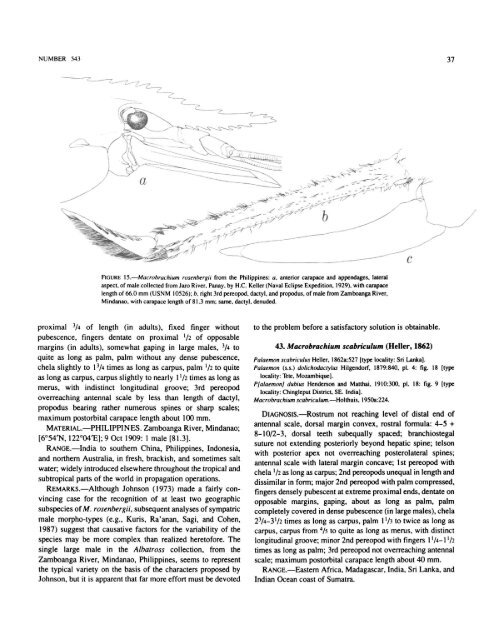Part 2 - AToL Decapoda
Part 2 - AToL Decapoda
Part 2 - AToL Decapoda
You also want an ePaper? Increase the reach of your titles
YUMPU automatically turns print PDFs into web optimized ePapers that Google loves.
NUMBER 543 37<br />
FIGURE 15.—Macrohrachium rosenbergii from the Philippines: a, anterior carapace and appendages, lateral<br />
aspect, of male collected from Jaro River, Panay, by H.C. Keller (Naval Eclipse Expedition, 1929), with carapace<br />
length of 66.0 mm (USNM 10526); b, right 3rd pereopod, dactyl, and propodus, of male from Zamboanga River,<br />
Mindanao, with carapace length of 81.3 mm; same, dactyl, denuded.<br />
proximal 3 A of length (in adults), fixed finger without<br />
pubescence, fingers dentate on proximal '/2 of opposable<br />
margins (in adults), somewhat gaping in large males, 3 /4 to<br />
quite as long as palm, palm without any dense pubescence,<br />
chela slightly to l 3 /4 times as long as carpus, palm x ji to quite<br />
as long as carpus, carpus slightly to nearly 1 '/2 times as long as<br />
merus, with indistinct longitudinal groove; 3rd pereopod<br />
overreaching antennal scale by less than length of dactyl,<br />
propodus bearing rather numerous spines or sharp scales;<br />
maximum postorbital carapace length about 100 mm.<br />
MATERIAL.—PHILIPPINES. Zamboanga River, Mindanao;<br />
[6°54'N, 122°04'E]; 9 Oct 1909: 1 male [81.3].<br />
RANGE.—India to southern China, Philippines, Indonesia,<br />
and northern Australia, in fresh, brackish, and sometimes salt<br />
water; widely introduced elsewhere throughout the tropical and<br />
subtropical parts of the world in propagation operations.<br />
REMARKS.—Although Johnson (1973) made a fairly convincing<br />
case for the recognition of at least two geographic<br />
subspecies of M. rosenbergii, subsequent analyses of sympatric<br />
male morpho-types (e.g., Kuris, Ra'anan, Sagi, and Cohen,<br />
1987) suggest that causative factors for the variability of the<br />
species may be more complex than realized heretofore. The<br />
single large male in the Albatross collection, from the<br />
Zamboanga River, Mindanao, Philippines, seems to represent<br />
the typical variety on the basis of the characters proposed by<br />
Johnson, but it is apparent that far more effort must be devoted<br />
to the problem before a satisfactory solution is obtainable.<br />
43. Macrobrachium scabriculum (Heller, 1862)<br />
Palaemon scahriculus Heller, 1862a:527 [type locality: Sri Lanka].<br />
Palaemon (s.s.) dolichodactylus Hilgendorf, 1879:840, pi. 4: fig. 18 [type<br />
locality: Tete, Mozambique].<br />
Plalaemon] dubius Henderson and Matthai, 1910:300, pi. 18: fig. 9 [type<br />
locality: Chingleput District, SE. India].<br />
Macrobrachium scabriculum.—Holthuis, 1950a:224.<br />
DIAGNOSIS.—Rostrum not reaching level of distal end of<br />
antennal scale, dorsal margin convex, rostral formula: 4-5 +<br />
8-10/2-3, dorsal teeth subequally spaced; branchiostegal<br />
suture not extending posteriorly beyond hepatic spine; telson<br />
with posterior apex not overreaching posterolateral spines;<br />
antennal scale with lateral margin concave; 1 st pereopod with<br />
chela '/2 as long as carpus; 2nd pereopods unequal in length and<br />
dissimilar in form; major 2nd pereopod with palm compressed,<br />
fingers densely pubescent at extreme proximal ends, dentate on<br />
opposable margins, gaping, about as long as palm, palm<br />
completely covered in dense pubescence (in large males), chela<br />
2 3 /4-3'/2 times as long as carpus, palm 1 '/3 to twice as long as<br />
carpus, carpus from 4 /5 to quite as long as merus, with distinct<br />
longitudinal groove; minor 2nd pereopod with fingers 1 'A-1 '/2<br />
times as long as palm; 3rd pereopod not overreaching antennal<br />
scale; maximum postorbital carapace length about 40 mm.<br />
RANGE.—Eastern Africa, Madagascar, India, Sri Lanka, and<br />
Indian Ocean coast of Sumatra.

















